Oct
30
2020
 The evolution of dogs from wolves is a long and complex one. A recent study adds some further information to this tale – as long as 11,000 years ago there were already at least five different distinct breeds of dog. These different breeds partly tracked along with human populations, but not completely. But let’s back up a bit and see where this new information fits into the story.
The evolution of dogs from wolves is a long and complex one. A recent study adds some further information to this tale – as long as 11,000 years ago there were already at least five different distinct breeds of dog. These different breeds partly tracked along with human populations, but not completely. But let’s back up a bit and see where this new information fits into the story.
Experts actually don’t agree on exactly when and where dogs first appeared, or even if it was one event or multiple independent origins. What is clear is that dogs are essentially domesticated wolves. Their likely origin was in Europe sometime between 19 and 32 thousand years ago. This makes dogs the first domesticated animal. I have often considered (being a life-long dog owner myself) how useful dogs would have been to ancient people. They are excellent guardians, sending up an alarm when anything strays too close to camp. My dog will let me know when racoons are poaching the bird feeder at 3am. They are territorial and will keep critters small and large out of the area. And in an emergency they will even fight for their masters. More developed and trained dogs can also do all sorts of jobs, from herding to hunting.
The extreme usefulness, not to mention companionship, of dogs to humans lead to the early hypothesis that humans domesticated wolves, probably by first raising wolf pups. Tamed wolves are more aggressive than dogs, but they can bond with humans and function in the human world. We know from the silver fox experiments that some mammal species can be significantly domesticated in just a few generations. So it would not take long for these tamed wolves to become more docile, loyal, and obedient. But experts now suspect this is not what actually happened.
The history of human and wolf interaction is mainly one of competition and eradications. Humans have always treated large predators as a threat. Wolves specifically have mostly been eradicated where humans flourish, often deliberately. This still does not preclude the exception of tamed wolves, but it did give rise to an alternate hypothesis – perhaps wolves domesticated humans rather than the other way around, meaning that it was the wolves who changed the nature of our relationship first. In this scenario wolf populations living near humans may have learned to poach at the edges of settlements, perhaps eating the bones or other refuse that humans discarded. The more cute and friendly wolves would have had more success at this strategy, while the more aggressive wolves would have been killed or driven off. This could have led to a subpopulation of friendly wolves mostly living off of human refuse. Selective pressures could have then quickly domesticated these proto-dog wolves, who were only later taken as companions by humans. Human selection would then have taken them the rest of the way to modern dogs.
Continue Reading »
Oct
29
2020
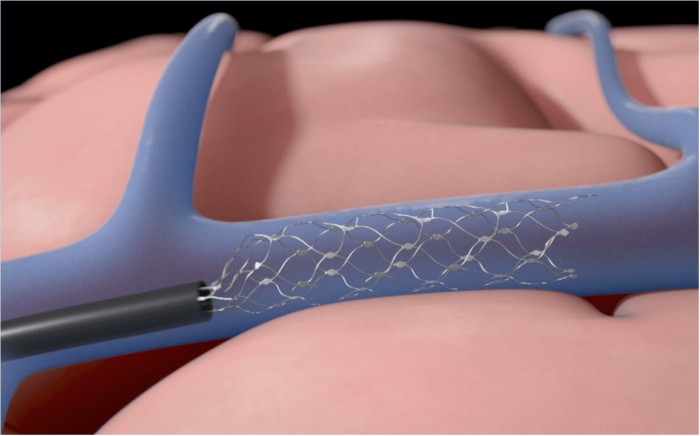 Brain-Machine interface (BMI) technology continues to incrementally but steadily progress, and I do think this is one of the technologies that will transform our future. Studies have already demonstrated that there are no biological or theoretical limitations to such technology – the brain happily communicates with computers and seamlessly incorporates signals to and from them through the existing process of brain plasticity. The real limitation with practical applications of BMI is technological, mostly in designing electrodes that can safely work for a long time.
Brain-Machine interface (BMI) technology continues to incrementally but steadily progress, and I do think this is one of the technologies that will transform our future. Studies have already demonstrated that there are no biological or theoretical limitations to such technology – the brain happily communicates with computers and seamlessly incorporates signals to and from them through the existing process of brain plasticity. The real limitation with practical applications of BMI is technological, mostly in designing electrodes that can safely work for a long time.
As I have discussed before, there are numerous approaches. Scalp surface electrodes are safe and easy, but have no resolution because the skull attenuates signals to and from the brain. Brain surface electrodes work much better, but they are invasive and tend to form scar tissue which can limit their lifespan. Microwires are a cutting edge approach, very thin hair-like wires that penetrate the brain, and can have both high resolution and long term safety. There is also the clever approach of putting the electrodes inside blood vessels in the brain. One company, Synchron, has been developing this technology since 2010 and their device, the Stentrode (a portmanteau of stent and electrode), has now completed a preliminary human trial.
The idea is to insert electrodes the way a stent would be placed inside a blood vessel to treat a blockage. The advantage here is that the endovascular stent technology already exists. They just had to make the stent out of electrodes, which they did. The huge advantage here is that you can get electrodes inside the skull and next to the brain without opening the skull or doing brain surgery. The brain itself is never penetrated. The electrodes are not as intimate with brain tissue as brain surface or penetrating electrodes, but that’s the tradeoff. The question is – how much efficacy can we get from endovascular electrodes?
Much of the research previously has been done on animals, mostly sheep and pigs. Initially the electrodes were connected directly to an external control device that also provides power. But this requires wires to go through the blood vessel to the outside, which is an infection risk. The latest design, the one studied recently, communicates wirelessly to a control box worn by the subject. The only mention I could find of how the electrodes are powered suggests they are powered wirelessly through this control box. This setup could potentially send and receive signals from the Stentrode.
Continue Reading »
Oct
27
2020
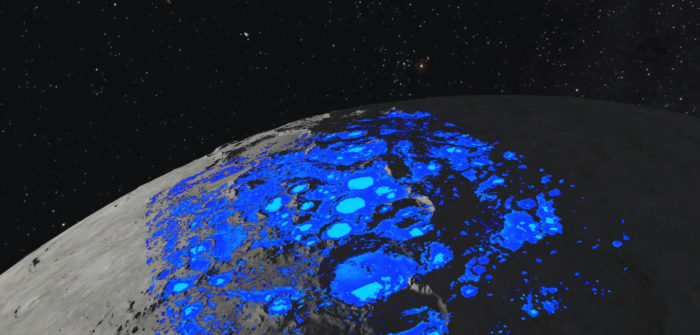 A new paper published in Nature Astronomy presents further evidence for significant water near the surface of the Moon. This is exciting news for the prospects of a lunar base, especially since NASA is planning on returning permanently to the Moon by 20204.
A new paper published in Nature Astronomy presents further evidence for significant water near the surface of the Moon. This is exciting news for the prospects of a lunar base, especially since NASA is planning on returning permanently to the Moon by 20204.
The Artemis program (Artemis is the twin sister of Apollo) plans to put the first woman and the next man on the lunar surface by 2024. Even if they don’t meet this ambitious timeframe, they will likely succeed sometime this decade. Unlike the “flags and footprint” mission design of Apollo, Artemis is designed for sustained exploration of the Moon. Artemis will use the space launch system, which will be the most powerful rocket in the world. In fact, the most powerful configuration of the SLS will be more powerful than the Saturn V rocket. This is because the SLS was designed no only to return to the Moon, but to be powerful enough to get to Mars, which is the ultimate goal.
On top of the SLS will be the Orion capsule, NASA’s deep space capsule. Orion can accommodate up to four astronauts, and is designed for multi-week missions. It will have exercise equipment, radiation shielding, and on board waste disposal. When they get to the Moon they will have a new lunar lander, currently in development. But unlike Apollo, NASA also plans on building the Gateway – a lunar orbiting platform for long term occupation and exploration of the Moon.
After the initial Artemis missions, NASA plans to create a basecamp near the south-pole of the Moon for long term occupation and exploration of the Moon. Why the south pole? In NASA-speak the poles, “may contain mission-enhancing volatiles.” In addition “These sites may also offer long-duration access to sunlight, direct-to-Earth communication, surface slope and roughness that will be less challenging for landers and astronauts.”
Continue Reading »
Oct
26
2020
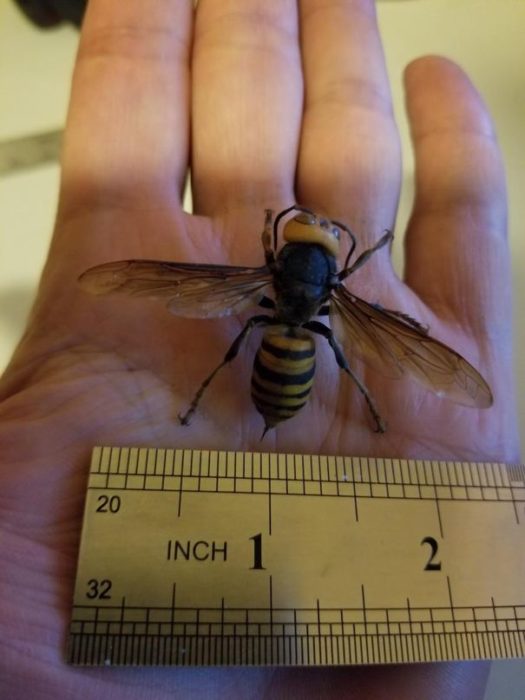 Invasive species can be a serious problem. They may lack predators to keep their populations in check, and some may be predators themselves, preying on species that cannot defend against them. Eventually a new equilibrium will be reached, but in the meantime this can be destabilizing and in the long term will reduce diversity. The “invasive species of the year” for 2020 has to be so-called “murder hornets”.
Invasive species can be a serious problem. They may lack predators to keep their populations in check, and some may be predators themselves, preying on species that cannot defend against them. Eventually a new equilibrium will be reached, but in the meantime this can be destabilizing and in the long term will reduce diversity. The “invasive species of the year” for 2020 has to be so-called “murder hornets”.
The proper name for this insect is the Asian giant hornet (Vespa mandarinia), and as the name implies it is native to temperate and tropical regions of Asia. It is the largest hornet species on Earth. As insects go, they are huge – “The hornet has a body length of 45 millimetres (1 3⁄4 inches), a wingspan around 75 mm (3 in), and a stinger 6 mm (1⁄4 in) long, which injects a large amount of potent venom.” Their nickname, “murder hornet”, derives from their behavior. They prey upon other insects, mainly honey bees, but also mantises and even other hornets. If they enter a honey bee nest, even a few hornets can wipe out the entire nest in several hours. They typically kill by decapitating the bees with their large mandibles. The bees defenses are all but useless – their stingers too small to penetrate the hornet’s armor.
They are not much of a direct threat to humans. Only about 40 people per year are killed in Asia from giant hornet stings. They are not generally aggressive, but will attack if they are threatened. They can sting multiple times, and their stinger is long enough to penetrate typical beekeeping suits. Their venom is known for producing incredible pain, and can cause some local tissue damage. So even if you don’t die, being stung will not be a pleasant experience. Their real threat to humans is indirect – from the threat they represent to our pollinators.
Continue Reading »
Oct
23
2020
 My skeptical colleague, James Randi, died earlier this week at the age of 92. He led a long, happy, and rich life and died with few meaningful regrets, and that is something to be celebrated. But we will also miss his wit and keen mind. He was one of the founders of modern skepticism, focusing his attention mainly on the consumer protection angle. He particularly delighted in exposing frauds and hucksters.
My skeptical colleague, James Randi, died earlier this week at the age of 92. He led a long, happy, and rich life and died with few meaningful regrets, and that is something to be celebrated. But we will also miss his wit and keen mind. He was one of the founders of modern skepticism, focusing his attention mainly on the consumer protection angle. He particularly delighted in exposing frauds and hucksters.
Randi came at skepticism through the magician path, which is not uncommon. Houdini, perhaps the most famous stage magician of all time, began this tradition by setting to expose the fake mediums of his time. Houdini realized that many of them were using standard magician stage tricks in order to fake seances. This is fine as a form of entertainment, but they were essentially tricking people into thinking they were contacting lost loved-ones in order to relieve them of excess cash. This practice continues to this day. As a magician himself, Houdini knew how to detect and expose their tricks.
Randi’s career in many ways is similar to Houdini’s but he helped spawn an entire movement of people, including scientists and philosophers, to help in the task. Randi told a story of his youth when he attended a faith-healing session. The pastor had people fill out “prayer cards” with their basic information and the ailment for which they sought healing. The pastor would appeal to the angels to bring him divine information about the next person who needed help. One person in the audience would cry out in joy and the pastor, seemingly through divine means, rattled off very specific information about them – information he could not have known.
Randi instantly recognized this as the old “one ahead trick”. The pastor was simply reciting the information he just read on the previous card, as if it were for the next person. This is a mentalism trick, meant to entertain, but being used to deceive. So Randi exposed the pastor for the trickster that he was, but those present did not thank him. They yelled at him, called him names, and ran him off. They were surprisingly ungrateful that Randi had popped their bubble of illusion and deception.
Continue Reading »
Oct
22
2020
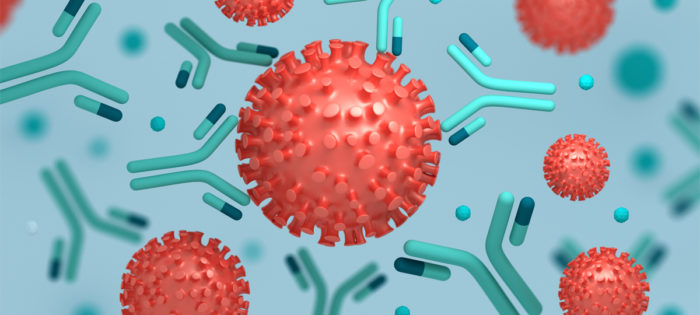 Over the course of the pandemic the death rate in people diagnosed with COVID-19 (the case-fatality rate) has declined. Unpacking all the reasons this may be the case can help us better understand and fight this disease. A few recent studies shed some light on this question. While there might be some encouraging news here, it highlights that this is still a “novel” virus and we have a lot to learn about the illness it causes.
Over the course of the pandemic the death rate in people diagnosed with COVID-19 (the case-fatality rate) has declined. Unpacking all the reasons this may be the case can help us better understand and fight this disease. A few recent studies shed some light on this question. While there might be some encouraging news here, it highlights that this is still a “novel” virus and we have a lot to learn about the illness it causes.
One recent study looking at the case fatality rate in the New York region from March to August found that the death rate for those admitted to the hospital dropped from 27% to 3%. They also found many possible reasons for this dramatic decrease. One is the fact that in March New York hospitals were overwhelmed with COVID cases. They did not have enough ICU beds or ventilators, and doctors were crushed beneath the initial wave of cases of a disease they had no experience with. So simply “flattening the curve” and reducing pressure on hospitals is one important factor.
The most encouraging reason for the decline is the steep learning curve of knowing how to treat those who are seriously ill with COVID. Doctors have learned through direct experience how to better manage COVID patients, and many interventions became standard practice between March and August. For example, it is better to rest patients on their stomach than their back, and it is better to delay ventilation as long as possible. The discovery that steroids can reduce the risk of cytokine storm was perhaps a significant improvement. Some patients now get convalescent plasma, something that obviously could not have happened early on. Remdesevir was given emergency use authorization, but a recent study by the WHO found no survival benefit from this drug (or from hydroxychloroquine, a combination of the anti-HIV drugs lopinavir and ritonavir; and interferon).
While we still do not have a cure for COVID-19 or a proven effective anti-viral, management has significantly improved and this has definitely contributed to survival. However – this is not the only effect, and may not even be the major effect.
Continue Reading »
Oct
20
2020
 In 2011 Daryl Bem published a series of ten studies which he claimed demonstrated psi phenomena – that people could “feel the future”. He took standard psychological study methods and simply reversed the order of events, so that the effect was measured prior to the stimulus. Bem claimed to find significant results – therefore psi is real. Skeptics and psychologists were not impressed, for various reasons. At the time, I wrote this:
In 2011 Daryl Bem published a series of ten studies which he claimed demonstrated psi phenomena – that people could “feel the future”. He took standard psychological study methods and simply reversed the order of events, so that the effect was measured prior to the stimulus. Bem claimed to find significant results – therefore psi is real. Skeptics and psychologists were not impressed, for various reasons. At the time, I wrote this:
Perhaps the best thing to come out of Bem’s research is an editorial to be printed with the studies – Why Psychologists Must Change the Way They Analyze Their Data: The Case of Psi by Eric Jan Wagenmakers, Ruud Wetzels, Denny Borsboom, & Han van der Maas from the University of Amsterdam. I urge you to read this paper in its entirety, and I am definitely adding this to my filing cabinet of seminal papers. They hit the nail absolutely on the head with their analysis.
Their primary point is this – when research finds positive results for an apparently impossible phenomenon, this is probably not telling us something new about the universe, but rather is probably telling us something very important about the limitations of our research methods
I interviewed Wagenmakers for the SGU, and he added some juicy tidbits. For example, Bem had previously authored a chapter in a textbook on research methodology in which he essentially advocated for p-hacking. This refers to a set of bad research methods that gives the researchers enough wiggle room to fudge the results, enough to make negative data seem statistically significant. This could be as seemingly innocent as deciding when to stop collecting data after you have already peeked at some of the results.
Richard Wiseman, who was one of the first psychologists to try to replicate Bem’s research and came up with negative results, recently published a paper discussing this very issue. In his blog post about the article he credits Bem’s research with being a significant motivator for improving research rigor in psychology:
Several researchers noted that the criticisms aimed at Bem’s work also applied to many studies from mainstream psychology. Many of the problems surrounded researchers changing their statistics and hypotheses after they had looked at their data, and so commentators urged researchers to submit a detailed description of their plans prior to running their studies. In 2013, psychologist Chris Chambers played a key role in getting the academic journal Cortex to adopt the procedure (known as a Registered Report), and many other journals quickly followed suit.
Continue Reading »
Oct
19
2020
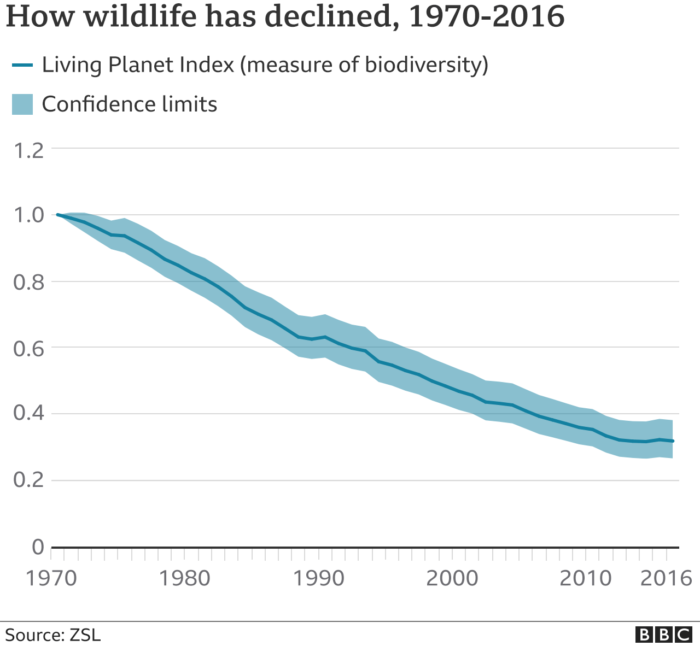 I consider myself a skeptical environmentalist, which is why I was really annoyed by the book by the same name by Bjørn Lomborg. The problem with Lomborg’s book was not the notion of reviewing the science behind the big environmental issues, but rather that he did such a poor job his treatment amounted to denialism, not skepticism. It as so bad, in fact, that Scientific American was motivated to dedicate an entire issue to systematically debunking his claims. This, of course, is part of a larger trend of tainting the word “skeptic” by using it to refer to science deniers and contrarions (and yes, there is a difference and denialism is a thing).
I consider myself a skeptical environmentalist, which is why I was really annoyed by the book by the same name by Bjørn Lomborg. The problem with Lomborg’s book was not the notion of reviewing the science behind the big environmental issues, but rather that he did such a poor job his treatment amounted to denialism, not skepticism. It as so bad, in fact, that Scientific American was motivated to dedicate an entire issue to systematically debunking his claims. This, of course, is part of a larger trend of tainting the word “skeptic” by using it to refer to science deniers and contrarions (and yes, there is a difference and denialism is a thing).
I am an environmentalist in the way that we should all be environmentalists – we should care about the biosphere in which we live. It is literally the only one we have. It is probable that human civilization will never have another, ever. Think about that. Interstellar travel will likely never be practical, and even if we can figure out a way to get to nearby systems, we will not find another Earth. Finding a world that is “earth-like” would require science-fiction level faster-than-light travel which may never be possible, and if it is will not happen anytime soon. Even then, there is a huge difference between “earth-like” and Earth. Terrforming other worlds in our solar system is also very difficult, and will take thousands of years if it is practical at all. So except for far future unpredictable scenarios – this is it. Our efforts are best spent preserving the world that is literally perfect for us, because we evolved here.
Beyond just surviving, I also love nature, perhaps more than the average person. Although people in general have an affinity for nature, and studies show that people are generally happier and healthier when they have exposure to nature. But as human civilization has grown, especially in the las century, we have displaced many natural ecosystems and impacted the environment in such a way as to stress many natural ecosystems. This is a serious issue because of, in a word, biodiversity.
Continue Reading »
Oct
16
2020
 Once again we have the reporting of a technological advance but leading with a bit of hype. The BBC headline is – “Superconductors: Material raises hope of energy revolution.” (Original article) I would first point out that I have been reading similar headlines since the 1980s. No revolution so far. We see some version of this claim every time there is an incremental advance in superconductor technology. We have hit a bit of a milestone with this latest progress, but it has to immediately be put into proper context.
Once again we have the reporting of a technological advance but leading with a bit of hype. The BBC headline is – “Superconductors: Material raises hope of energy revolution.” (Original article) I would first point out that I have been reading similar headlines since the 1980s. No revolution so far. We see some version of this claim every time there is an incremental advance in superconductor technology. We have hit a bit of a milestone with this latest progress, but it has to immediately be put into proper context.
Scientists have indeed demonstrated the first room temperature superconductor. But you know there’s a catch, right?
The scientists observed the superconducting behaviour in a carbonaceous sulphur hydride compound at a temperature of 15C.
However, the property only appeared at extremely high pressures of 267 billion pascals – about a million times higher than typical tyre pressure. This obviously limits its practical usefulness.
“Limits its practical usefulness” is perhaps a bit of typical British understatement. The way I see it they have just substituted one highly impractical limitation of superconducting material (extreme low temperatures) with another (extreme pressure). The research could have easily gone the other way. What if the high pressure superconductors were discovered first, then the holy grail would have been finding a superconductor at normal pressures, which they could have done by using extremely low temperatures. In fact, the low temperature may be the easier of the two.
At atmospheric pressure the record is still held by cuprates, which have demonstrated superconductivity at temperatures as high as 138 K (−135 °C).
It is easier to cool something to -135 °C then to put it under 267 billion pascals of pressure, so you might even argue we have taken a step backwards. This still might be useful if the research leads down a new path that ends with room temperature and atmospheric pressure superconductivity. Perhaps we’ll see in another 30 years.
Continue Reading »
Oct
15
2020
 The headline reads, “Physicists build circuit that generates clean, limitless power from graphene.” There are some red flags there – my skeptical antenna always prick up when I see claims of limitless power. However, unlike the silly caricature of those who push back against appropriate skepticism, my doubts were the beginning of the process, not the end. I had many questions. How much power are we talking about? Where is the energy coming from (always a good question)? Does this require “free energy” or breaking any of the laws of thermodynamics? Is this theoretical or does it exist?
The headline reads, “Physicists build circuit that generates clean, limitless power from graphene.” There are some red flags there – my skeptical antenna always prick up when I see claims of limitless power. However, unlike the silly caricature of those who push back against appropriate skepticism, my doubts were the beginning of the process, not the end. I had many questions. How much power are we talking about? Where is the energy coming from (always a good question)? Does this require “free energy” or breaking any of the laws of thermodynamics? Is this theoretical or does it exist?
The press release, as is often the case, did not delve into these questions to a satisfactory degree, but was mainly hype. So I went to the original article – Fluctuation-induced current from freestanding graphene. (Sorry, it’s behind a paywall, but I had access through my institution.) This helped, but was technically over my head in some parts. What I needed was to talk to an expert who could translate the technical bits for me. We discussed this news item, as much as we could, on the SGU and asked for help getting in touch with someone who could help unpack the physics at work here. Listener David Thompson, who is at the University of Arkansas where the research was done, was able to hook us up to the lead author of the study, Paul Thibado. We interviewed him yesterday for the show that will air this Saturday. Listen to the interview for all the details, but here is a quick breakdown.
The claim is that Thibado and his group have built a circuit that can harvest electrical energy from freestanding graphene. Graphene is a 2-dimensional material of carbon, think of a chickenwire with carbon atoms at each of the connection points. Graphene has interesting properties, and we are still near the beginning of exploring possible applications of this material. Freestanding graphene means the sheet is floating like a picture in a frame – this allows it to move freely. This sheet of graphene will undulate, buckle, and wave (like the surface of the ocean) due to background energy in a form a Brownian motion. The question Thibado and his group asked is this – can we harvest energy from the motion of the graphene, in the same way that you might harvest energy from the wind blowing or the sun shining? The answer, they found, is yes.
Continue Reading »
 The evolution of dogs from wolves is a long and complex one. A recent study adds some further information to this tale – as long as 11,000 years ago there were already at least five different distinct breeds of dog. These different breeds partly tracked along with human populations, but not completely. But let’s back up a bit and see where this new information fits into the story.
The evolution of dogs from wolves is a long and complex one. A recent study adds some further information to this tale – as long as 11,000 years ago there were already at least five different distinct breeds of dog. These different breeds partly tracked along with human populations, but not completely. But let’s back up a bit and see where this new information fits into the story.
 Brain-Machine interface (BMI) technology continues to incrementally but steadily progress, and I do think this is one of the technologies that will transform our future. Studies have already demonstrated that there are no biological or theoretical limitations to such technology – the brain happily communicates with computers and seamlessly incorporates signals to and from them through the existing process of brain plasticity. The real limitation with practical applications of BMI is technological, mostly in designing electrodes that can safely work for a long time.
Brain-Machine interface (BMI) technology continues to incrementally but steadily progress, and I do think this is one of the technologies that will transform our future. Studies have already demonstrated that there are no biological or theoretical limitations to such technology – the brain happily communicates with computers and seamlessly incorporates signals to and from them through the existing process of brain plasticity. The real limitation with practical applications of BMI is technological, mostly in designing electrodes that can safely work for a long time. A new paper
A new paper  Invasive species can be a serious problem. They may lack predators to keep their populations in check, and some may be predators themselves, preying on species that cannot defend against them. Eventually a new equilibrium will be reached, but in the meantime this can be destabilizing and in the long term will reduce diversity. The “invasive species of the year” for 2020 has to be so-called “murder hornets”.
Invasive species can be a serious problem. They may lack predators to keep their populations in check, and some may be predators themselves, preying on species that cannot defend against them. Eventually a new equilibrium will be reached, but in the meantime this can be destabilizing and in the long term will reduce diversity. The “invasive species of the year” for 2020 has to be so-called “murder hornets”. My skeptical colleague, James Randi, died earlier this week at the age of 92. He led a long, happy, and rich life and died with few meaningful regrets, and that is something to be celebrated. But we will also miss his wit and keen mind. He was one of the founders of modern skepticism, focusing his attention mainly on the consumer protection angle. He particularly delighted in exposing frauds and hucksters.
My skeptical colleague, James Randi, died earlier this week at the age of 92. He led a long, happy, and rich life and died with few meaningful regrets, and that is something to be celebrated. But we will also miss his wit and keen mind. He was one of the founders of modern skepticism, focusing his attention mainly on the consumer protection angle. He particularly delighted in exposing frauds and hucksters. Over the course of the pandemic the death rate in people diagnosed with COVID-19 (the case-fatality rate) has declined. Unpacking all the reasons this may be the case can help us better understand and fight this disease. A few recent studies shed some light on this question. While there might be some encouraging news here, it highlights that this is still a “novel” virus and we have a lot to learn about the illness it causes.
Over the course of the pandemic the death rate in people diagnosed with COVID-19 (the case-fatality rate) has declined. Unpacking all the reasons this may be the case can help us better understand and fight this disease. A few recent studies shed some light on this question. While there might be some encouraging news here, it highlights that this is still a “novel” virus and we have a lot to learn about the illness it causes. In 2011 Daryl Bem
In 2011 Daryl Bem  I consider myself a skeptical environmentalist, which is why I was really annoyed by the book by the same name by Bjørn Lomborg. The problem with Lomborg’s book was not the notion of reviewing the science behind the big environmental issues, but rather that he did such a poor job his treatment amounted to denialism, not skepticism. It as so bad, in fact,
I consider myself a skeptical environmentalist, which is why I was really annoyed by the book by the same name by Bjørn Lomborg. The problem with Lomborg’s book was not the notion of reviewing the science behind the big environmental issues, but rather that he did such a poor job his treatment amounted to denialism, not skepticism. It as so bad, in fact,  Once again we have the reporting of a technological advance but leading with a bit of hype. The BBC headline is – “
Once again we have the reporting of a technological advance but leading with a bit of hype. The BBC headline is – “ The headline reads, “
The headline reads, “




